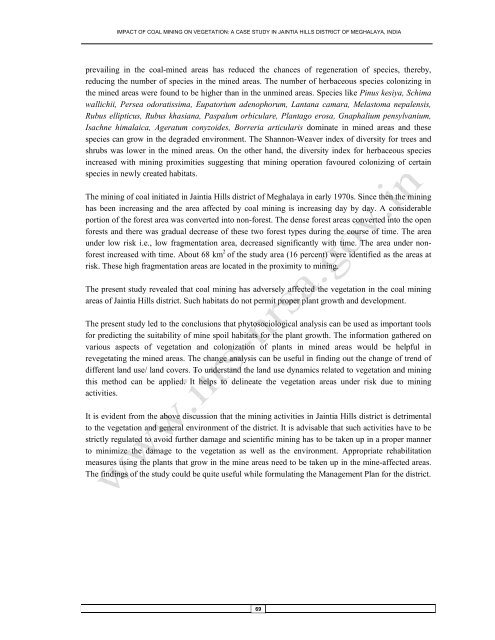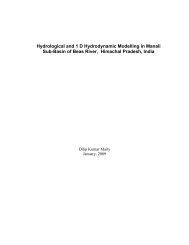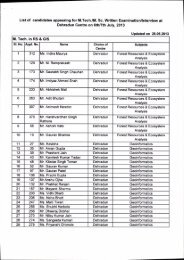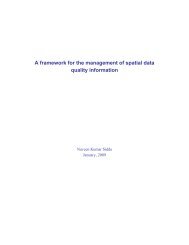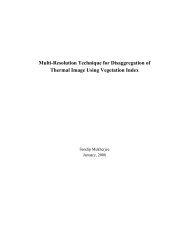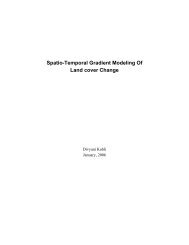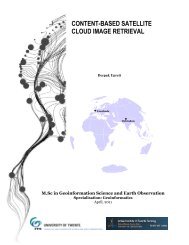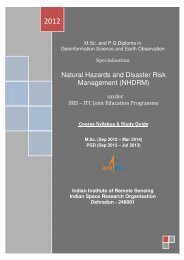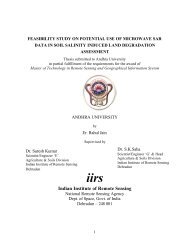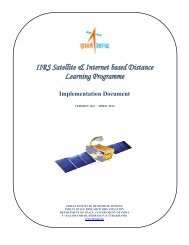Impact of Coal Mining on Vegetation: A Case Study in Jaintia Hills ...
Impact of Coal Mining on Vegetation: A Case Study in Jaintia Hills ...
Impact of Coal Mining on Vegetation: A Case Study in Jaintia Hills ...
You also want an ePaper? Increase the reach of your titles
YUMPU automatically turns print PDFs into web optimized ePapers that Google loves.
IMPACT OF COAL MINING ON VEGETATION: A CASE STUDY IN JAINTIA HILLS DISTRICT OF MEGHALAYA, INDIAprevail<strong>in</strong>g <strong>in</strong> the coal-m<strong>in</strong>ed areas has reduced the chances <str<strong>on</strong>g>of</str<strong>on</strong>g> regenerati<strong>on</strong> <str<strong>on</strong>g>of</str<strong>on</strong>g> species, thereby,reduc<strong>in</strong>g the number <str<strong>on</strong>g>of</str<strong>on</strong>g> species <strong>in</strong> the m<strong>in</strong>ed areas. The number <str<strong>on</strong>g>of</str<strong>on</strong>g> herbaceous species col<strong>on</strong>iz<strong>in</strong>g <strong>in</strong>the m<strong>in</strong>ed areas were found to be higher than <strong>in</strong> the unm<strong>in</strong>ed areas. Species like P<strong>in</strong>us kesiya, Schimawallichii, Persea odoratissima, Eupatorium adenophorum, Lantana camara, Melastoma nepalensis,Rubus ellipticus, Rubus khasiana, Paspalum orbiculare, Plantago erosa, Gnaphalium pensylvanium,Isachne himalaica, Ageratum c<strong>on</strong>yzoides, Borreria articularis dom<strong>in</strong>ate <strong>in</strong> m<strong>in</strong>ed areas and thesespecies can grow <strong>in</strong> the degraded envir<strong>on</strong>ment. The Shann<strong>on</strong>-Weaver <strong>in</strong>dex <str<strong>on</strong>g>of</str<strong>on</strong>g> diversity for trees andshrubs was lower <strong>in</strong> the m<strong>in</strong>ed areas. On the other hand, the diversity <strong>in</strong>dex for herbaceous species<strong>in</strong>creased with m<strong>in</strong><strong>in</strong>g proximities suggest<strong>in</strong>g that m<strong>in</strong><strong>in</strong>g operati<strong>on</strong> favoured col<strong>on</strong>iz<strong>in</strong>g <str<strong>on</strong>g>of</str<strong>on</strong>g> certa<strong>in</strong>species <strong>in</strong> newly created habitats.The m<strong>in</strong><strong>in</strong>g <str<strong>on</strong>g>of</str<strong>on</strong>g> coal <strong>in</strong>itiated <strong>in</strong> Ja<strong>in</strong>tia <strong>Hills</strong> district <str<strong>on</strong>g>of</str<strong>on</strong>g> Meghalaya <strong>in</strong> early 1970s. S<strong>in</strong>ce then the m<strong>in</strong><strong>in</strong>ghas been <strong>in</strong>creas<strong>in</strong>g and the area affected by coal m<strong>in</strong><strong>in</strong>g is <strong>in</strong>creas<strong>in</strong>g day by day. A c<strong>on</strong>siderableporti<strong>on</strong> <str<strong>on</strong>g>of</str<strong>on</strong>g> the forest area was c<strong>on</strong>verted <strong>in</strong>to n<strong>on</strong>-forest. The dense forest areas c<strong>on</strong>verted <strong>in</strong>to the openforests and there was gradual decrease <str<strong>on</strong>g>of</str<strong>on</strong>g> these two forest types dur<strong>in</strong>g the course <str<strong>on</strong>g>of</str<strong>on</strong>g> time. The areaunder low risk i.e., low fragmentati<strong>on</strong> area, decreased significantly with time. The area under n<strong>on</strong>forest<strong>in</strong>creased with time. About 68 km 2 <str<strong>on</strong>g>of</str<strong>on</strong>g> the study area (16 percent) were identified as the areas atrisk. These high fragmentati<strong>on</strong> areas are located <strong>in</strong> the proximity to m<strong>in</strong><strong>in</strong>g.The present study revealed that coal m<strong>in</strong><strong>in</strong>g has adversely affected the vegetati<strong>on</strong> <strong>in</strong> the coal m<strong>in</strong><strong>in</strong>gareas <str<strong>on</strong>g>of</str<strong>on</strong>g> Ja<strong>in</strong>tia <strong>Hills</strong> district. Such habitats do not permit proper plant growth and development.The present study led to the c<strong>on</strong>clusi<strong>on</strong>s that phytosociological analysis can be used as important toolsfor predict<strong>in</strong>g the suitability <str<strong>on</strong>g>of</str<strong>on</strong>g> m<strong>in</strong>e spoil habitats for the plant growth. The <strong>in</strong>formati<strong>on</strong> gathered <strong>on</strong>various aspects <str<strong>on</strong>g>of</str<strong>on</strong>g> vegetati<strong>on</strong> and col<strong>on</strong>izati<strong>on</strong> <str<strong>on</strong>g>of</str<strong>on</strong>g> plants <strong>in</strong> m<strong>in</strong>ed areas would be helpful <strong>in</strong>revegetat<strong>in</strong>g the m<strong>in</strong>ed areas. The change analysis can be useful <strong>in</strong> f<strong>in</strong>d<strong>in</strong>g out the change <str<strong>on</strong>g>of</str<strong>on</strong>g> trend <str<strong>on</strong>g>of</str<strong>on</strong>g>different land use/ land covers. To understand the land use dynamics related to vegetati<strong>on</strong> and m<strong>in</strong><strong>in</strong>gthis method can be applied. It helps to del<strong>in</strong>eate the vegetati<strong>on</strong> areas under risk due to m<strong>in</strong><strong>in</strong>gactivities.It is evident from the above discussi<strong>on</strong> that the m<strong>in</strong><strong>in</strong>g activities <strong>in</strong> Ja<strong>in</strong>tia <strong>Hills</strong> district is detrimentalto the vegetati<strong>on</strong> and general envir<strong>on</strong>ment <str<strong>on</strong>g>of</str<strong>on</strong>g> the district. It is advisable that such activities have to bestrictly regulated to avoid further damage and scientific m<strong>in</strong><strong>in</strong>g has to be taken up <strong>in</strong> a proper mannerto m<strong>in</strong>imize the damage to the vegetati<strong>on</strong> as well as the envir<strong>on</strong>ment. Appropriate rehabilitati<strong>on</strong>measures us<strong>in</strong>g the plants that grow <strong>in</strong> the m<strong>in</strong>e areas need to be taken up <strong>in</strong> the m<strong>in</strong>e-affected areas.The f<strong>in</strong>d<strong>in</strong>gs <str<strong>on</strong>g>of</str<strong>on</strong>g> the study could be quite useful while formulat<strong>in</strong>g the Management Plan for the district.69


